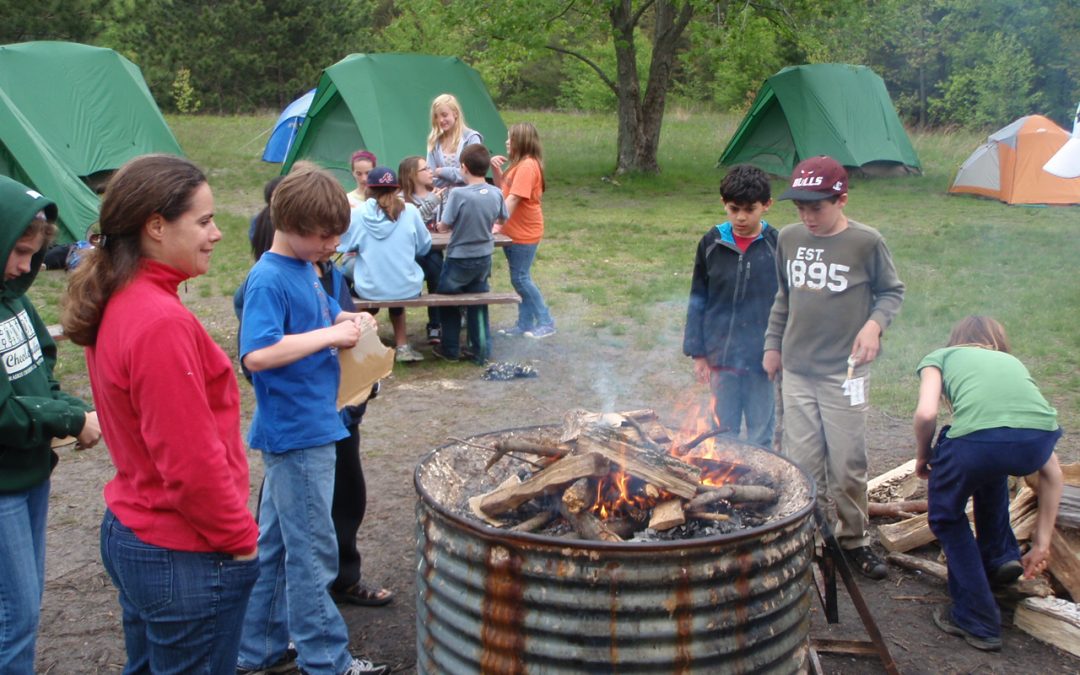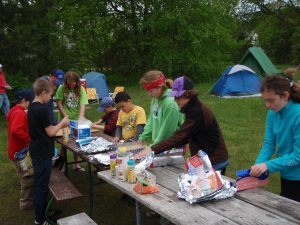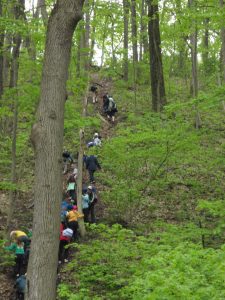By. Naomi Hershiser, Dean of Environmental Learning, Prairie Crossing Charter School
As a student, my elementary and middle school PE experiences were pretty much confined to team sports and games – the traditional sort like basketball and the kinds that seem to only show up in school curricula and Vince Vaughn movies, like dodgeball. For some students, these activities provide them with the skills and knowledge to pursue active and healthy lifestyles into adulthood. However, I am not a team sport enthusiast, and this limited definition of physical activity left me unprepared to lead a healthy lifestyle as an adult. How I wish that my school had provided me with the opportunity to engage in physical activities that spoke more to my personality and proclivities, endeavors that would not only allow me to be outside in nature but ones that I could pursue on my own or with colleagues in a non-competitive forum!
At Prairie Crossing Charter School in Grayslake, Illinois, we provide our students with a range of experiences that are designed to keep them active and outside – now and into the future. Throughout their years, students engage in a variety of outdoor recreation pursuits that meet their academic, social-emotional, and physical needs. Students build forts, take hikes, and go bird-watching. They paddle canoes and pedal bicycles. They garden, track animals, and use snowshoes. (As a side note, our PE curriculum is not solely focused on team sports and games. It, too, endeavors to accommodate a multitude of student personalities and prepare them to lead physically fit lifestyles!)
One of the highlights of Prairie Crossing’s outdoor recreation experiences is the camping trips that students take during their fifth- and sixth-grade years. On these trips, students learn and practice a variety of skills – such as fire-building, outdoor cooking, tent set-up and care – that will prepare them to go camping with their families or as adults. In addition, they spend their days deeply engaged in intense nature immersion, physical activity, and group bonding.
We rotate our camping trips between two state parks, chosen after many years of trying parks within a three-hour radius of our school. Starved Rock State Park in Illinois offers spectacular slot canyons, interesting geological features, and a forested riparian corridor. Warren Dunes State Park in Michigan has coastal beaches and towering sand dunes. Together, these parks provide great diversity and points of comparison to our school campus, which gives us access to prairies and wetlands. Each park also has nice group campsites and trails that allow for five to six hours of hiking for our students.
Our camping trips are three days (two nights) long. Students travel via bus to the state park; upon arrival, they set up their tents and get settled in before embarking on a hike to explore the area. Dinner (and subsequent meals) are cooked by students working in rotating crews – the fire crew, which starts and maintains the fire; the cooking crew, which organizes, prepares, and serves the food; and the cleaning crew, which sets up dishwashing stations for personal dishes and cleans serving dishes. Evenings finish with campfire time, which is a great opportunity to perform skits or performances related to curriculum, tell stories and sing songs, or just chat.
On the second day, between cooking breakfast and dinner, students hike for approximately seven miles, stopping en route to nature journal, eat lunch, and complete assignments. For example, at Warren Dunes State Park, students learn about the work of artist Andy Goldsworthy and create their own ephemeral sculptures from natural objects found on the shoreline. At Starved Rock State Park, students visit the nature center and learn about the cultural and natural history of the area. Other activities in which students engage in along the trails include completing comparisons of these new habitats with the prairie around our school and learning about the plants that grow in these areas. Of course, time is always allotted for students to just explore and enjoy the natural area they are in. After a full day of hiking and activities, students finish with dinner and another campfire.
The final day of the trip is mainly devoted to breaking camp, traveling home, and dealing with supplies. Students must steward the camping equipment as part of their trip, making sure it is ready for the next group of travelers!
Camping provides many benefits to students and their teachers. For one, it allows them to see each other in a different light. Teachers can get to know their students in a personal way. There is a well-documented correlation between student performance and the relationship between students and their teachers. Learning is more successful when students feel that their teachers care about the things they care about and their lives outside of school. Traveling, eating, hiking, and sitting around a campfire together provide ideal opportunities for these relationships to develop. This can be especially important for struggling students, who may be accustomed to having most of their interaction with teachers be about missing work, deficits, or other stressful topics.
Students also get to see each other in new ways. Camping forges new friendships and strengthens existing ones. Completing tasks such as putting up a tent or starting a fire provide opportunities for teamwork and require effective communication with all group members. They also engage in problem-solving skills to accomplish these tasks (what is the best order for the food buffet to go in? How can we reach the tent roof which is two feet taller than us?). Practicing critical thinking in a real-life context is extremely valuable.
For many students, these trips provide a first, safe experience away from home, allowing them to grow and become more mature. They also learn personal responsibility. Says sixth-grade teacher Chris Hershiser, “I’ve been camping with students for over 17 years. Every time we go I see some improvement, some way that a student comes back from the trip changed. Sometimes it’s a small change but other times it’s a remarkable new outlook. For example, students come back more responsible after being in charge of their own supplies and being responsible for making sure that meals work smoothly.”
Campouts are an immersive experience with the natural world, and they are technology free! While technology plays an important and necessary role in the modern world, being able to live tech-free for a few days is also an important skill and accomplishment for many students to achieve. In addition, these trips allow students to make natural discoveries that simply are not possible in the schoolyard. I recall one trip when a class sat and watched two pileated woodpeckers circle a tree just twenty feet from where they were standing – this does not happen in our suburban environment! Students get to climb up and run down endless sand dunes and stand under waterfalls in slot canyons. There are many wonderful learning opportunities in the vicinity of our school, but these more immersive experiences simply would not be possible without travel.
Finally, of course, there are the recreation benefits. Students learn skills that could lead to new potential hobbies – hobbies that are “green” and low-impact. They spend their days being physically active (there are no couch potatoes in camping!) and experience first-hand how good it feels to finish a long hike, prepare your own meals, and live closely with the land. Camping in school paves the way for life-long choices that are healthy and low-impact.
The benefits of physical activity are well-documented; exercise improves physical and mental health. As anyone who works with students well knows, there is no one-size-fits-all in matters of meeting the personality, lifestyles, and learning styles of the diverse population in our schools. By offering a variety of outdoor and naturally immersive activities that involve physical movement, we reach a whole different segment of the student population, offering them options for recreation and fitness that go beyond traditional team sports and gym workouts…all while providing nature education!
Author Bio
Naomi Dietzel Hershiser is the Dean of Environmental Learning at Prairie Crossing Charter School (PCCS), where she works with students and teachers to incorporate environmental learning into the daily school experience. Before starting at PCCS in 2003, Naomi taught environmental education in informal settings at nature centers and museums. Naomi earned a MAT from Dominican University, an Environmental Education certification from UMD, and a BA from Carleton College. When she’s not working, Naomi enjoys running, gardening, and reading.



